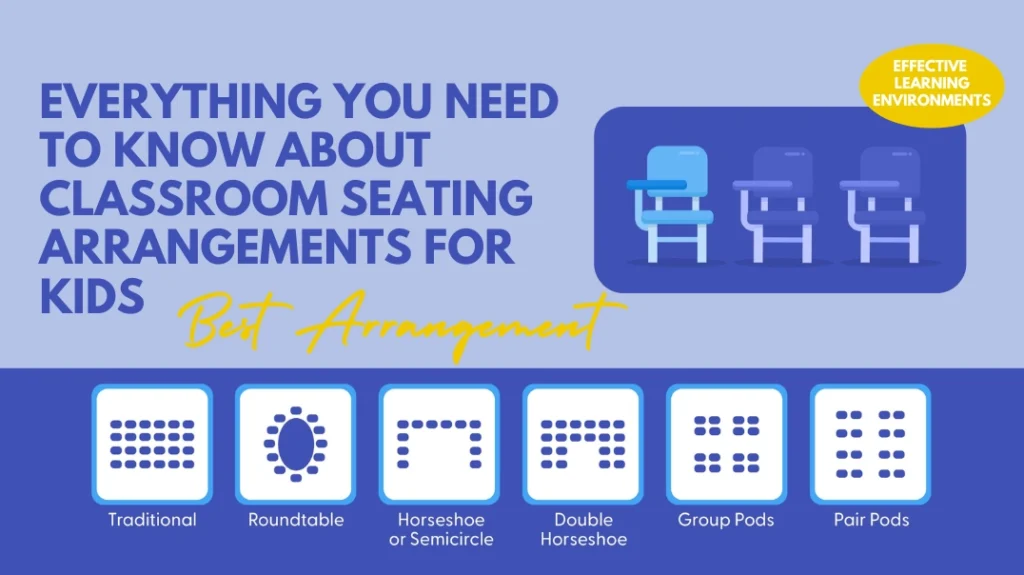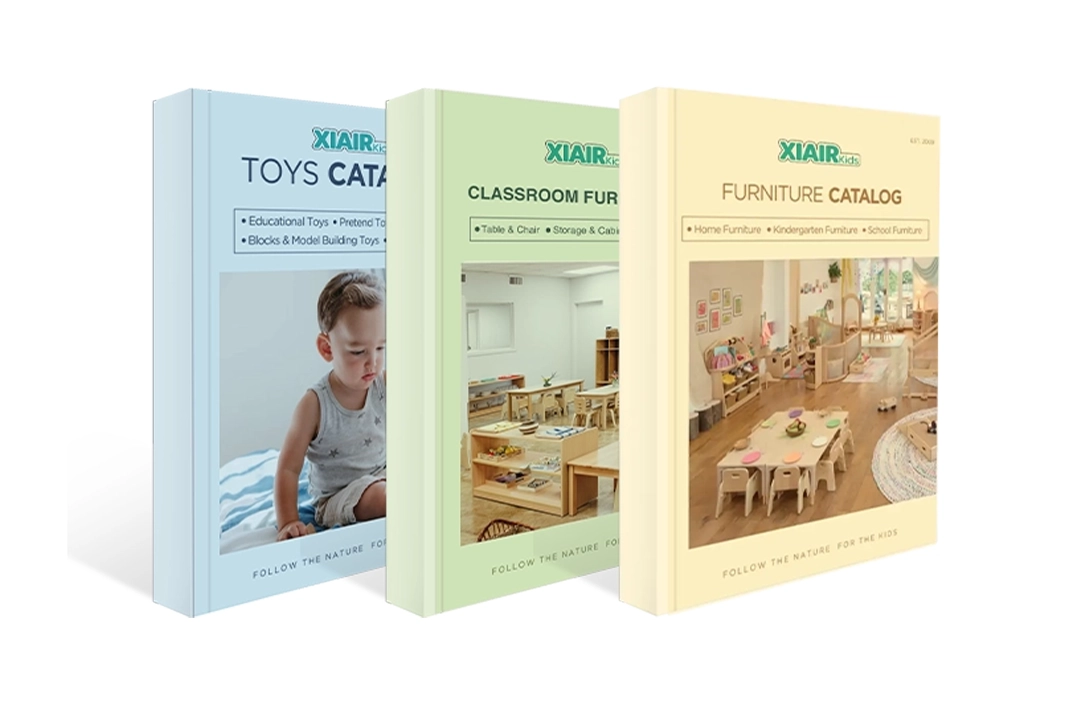Have you ever walked into a classroom and noticed students struggling to focus, getting easily distracted, or feeling disconnected from the lesson? It’s a common challenge, especially in kindergarten and elementary classrooms where kids are full of energy and curiosity. How tables and chairs are arranged might seem like a small detail, but it plays a massive role in how well students engage, communicate, and absorb information. A poor seating setup can lead to constant disruptions, difficulty maintaining attention, and even behavioral issues.
A classroom where every child can see the teacher, easily interact with their peers, and feel comfortable in their learning space. Picture students who stay focused because their classroom seating arrangement naturally supports independent work and group activities. In such an environment, teachers spend less time managing distractions and more time teaching. But when seating is poorly arranged, even the most engaging lesson plans can fail. Some students may struggle to see the board, while others get lost in a sea of distractions.
Choosing the proper classroom seating arrangements can transform the learning experience. Teachers can create a space that encourages learning, collaboration, and engagement by understanding different layouts and how they affect student behavior, participation, and focus. This guide explores the most practical classroom seating arrangements for kids, their advantages and disadvantages, and valuable tips to help you design a classroom that genuinely supports children.
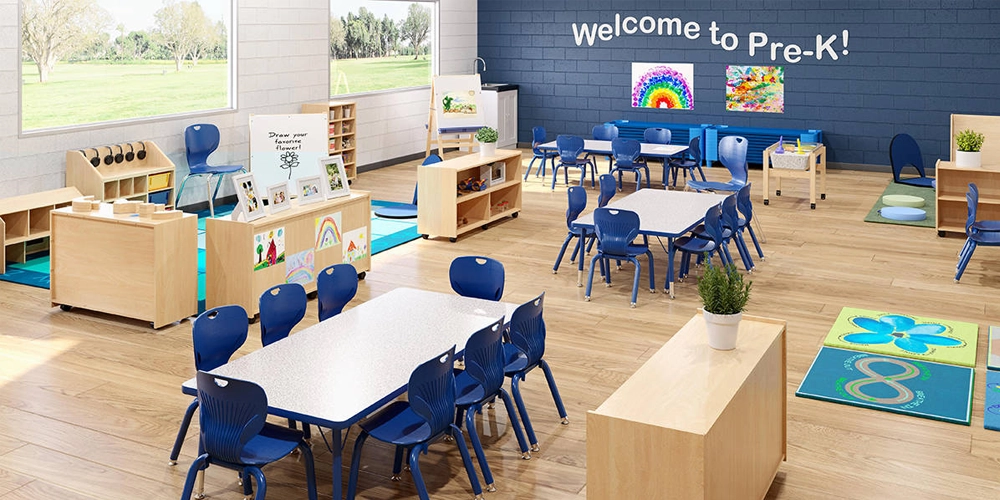
What is a Classroom Seating Arrangements?
Classroom seating arrangements organize desks, chairs, and other seating options in a learning space. They determine where students sit, how they interact with their peers, and how they engage with the teacher and learning materials. A classroom’s layout can be structured and traditional, like rows and columns, or flexible and collaborative, like group seating or U-shaped arrangements.
Classroom seating arrangements are critical in classroom management, student behavior, and learning outcomes. A well-planned layout can help students stay focused, comfortable, and actively involved, while a poor design may lead to distractions, disengagement, and communication difficulties.
Teachers often adjust classroom seating arrangements based on class size, student needs, and lesson objectives. For example, kindergarten children may benefit from sitting in small groups to encourage play-based learning, while elementary school students may need a mix of independent and collaborative seating options.
Why Is Seating Arrangement Important in Early Childhood Education?
Classroom seating arrangements in early childhood education significantly impact how children learn, interact, and develop essential skills. At this stage, kids are still learning to follow routines, communicate with peers, and focus on tasks, so how they are seated can either support or hinder their development.
Here’s why a well-planned seating arrangement is crucial for kids:
Encourages Social Interaction
Seating children in small groups or pods allows them to develop teamwork and communication skills. This is especially important in preschool and kindergarten, where children learn through collaborative play and discussions.
Improves Focus and Engagement
Some students get easily distracted, while others need more support from the teacher. Strategic seating can help minimize distractions and ensure every child receives the attention they need.
Supports Different Learning Styles
Some kids learn best by watching, while others need to move around or work hands-on. Flexible classroom seating arrangements allow teachers to accommodate visual, auditory, and kinesthetic learners.
Enhances Classroom Management
A good seating plan helps teachers monitor behavior, prevent disruptions, and create a positive learning environment. For example, placing active or talkative students near the teacher can help keep them on task.
Creates a Comfortable Learning Space
Children need to feel safe and comfortable in their classrooms. Arranging seats in a way that reduces anxiety and promotes inclusivity can make a big difference in their learning experience.
How Seating Arrangements Impact Children’s Development and Engagement
How a classroom is arranged directly affects how children learn, interact, and participate in class activities. A poorly designed seating plan can make it difficult for students to stay engaged, communicate effectively, and focus on lessons. On the other hand, a thoughtful classroom seating arrangement can enhance learning and social development in many ways.
Boosts Attention and Concentration – Some students need to sit closer to the teacher to stay focused, while others work best in quiet corners with fewer distractions. Teachers can use classroom seating arrangements to ensure that every child is positioned in a way that helps them learn best.
Encourages Active Participation—Classroom seating arrangements like U-shapes, circles, or group tables allow students to engage more in discussions and activities. Kids who can see and hear each other quickly feel more encouraged to share ideas and ask questions.
Supports Peer Learning and Collaboration – Children thrive in interactive environments. Arranging desks in clusters or small groups encourages children to help each other, share materials, and work as a team, which improves problem-solving and communication skills.
Reduces Behavioral Issues – A good classroom seating arrangement helps prevent disruptions and maintain order. Teachers can separate easily distracted students, place shy students in comfortable positions, and ensure that students with special needs have accessible seating.
Creates a Sense of Belonging – When students feel comfortable in their learning space, they are more confident, engaged, and willing to participate. A well-planned classroom seating arrangement ensures that every child feels included and valued.
By choosing the proper seating layout, teachers can improve student engagement, behavior, and the overall learning experience, making the classroom a place where every child can thrive.
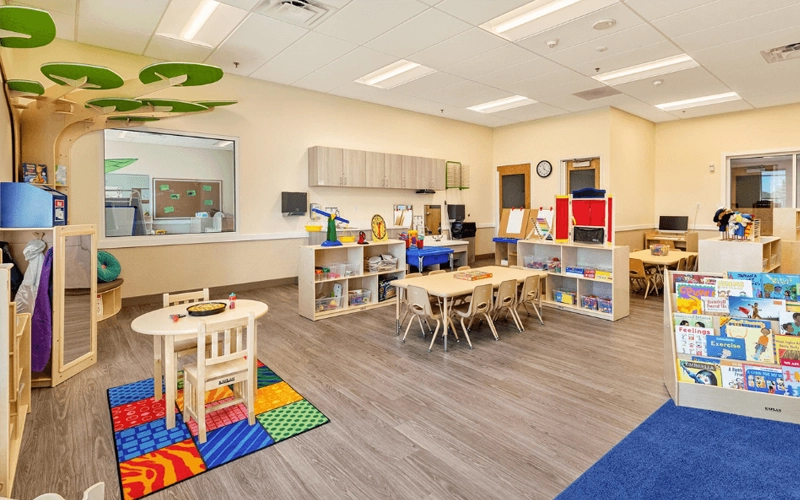
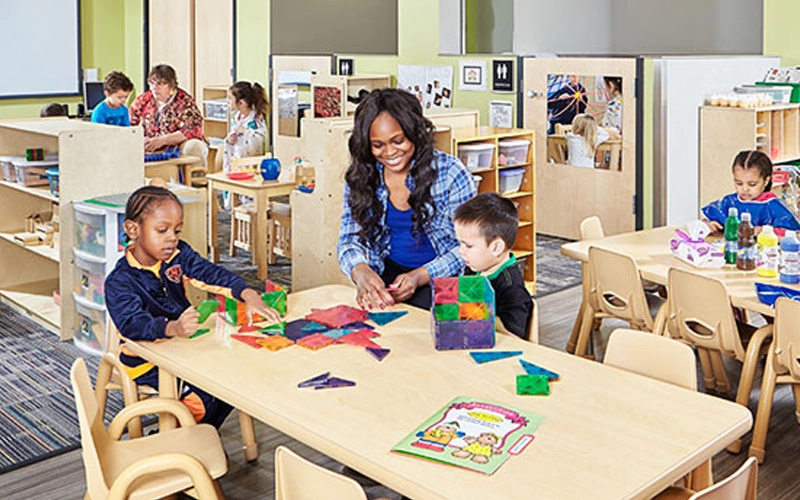
Key Factors in Choosing the Right Seating Arrangement
Selecting the proper classroom seating arrangements is not just about organizing desks—it’s about creating an environment where students can focus, interact, and feel comfortable. Several key factors influence how a seating plan should be designed, especially for kindergarten and elementary school learners.
Classroom Size and Layout Considerations
The size and shape of a classroom significantly affect classroom seating arrangements. A small classroom with limited space may require compact seating plans, like rows or pods, to maximize movement. A more extensive classroom, on the other hand, allows for flexible seating options, such as U-shaped layouts or collaborative stations.
- Clear pathways for easy movement and safety
- Teacher visibility to ensure all students can be seen and heard
- Space for group activities without crowding the room
For kids, having an open, accessible layout encourages movement and hands-on learning, which is crucial for their development. Teachers can use multi-functional furniture in classrooms with limited space, such as stackable chairs or movable desks, for quick reconfiguration based on lesson needs.
Student Needs and Learning Styles
Every child learns differently, so a good seating plan should accommodate various learning styles:
- Visual learners need a clear view of the teacher and board, so they often sit in the front or middle rows.
- Auditory learners benefit from sitting near discussion areas to engage in conversations.
- Kinesthetic learners require flexible spaces, such as standing desks or areas where they can move comfortably.
Grouping students with complementary learning styles can also encourage peer learning and engagement. For example, pairing a visual learner with an auditory learner in a collaborative classroom seating arrangement can help students absorb information differently.
Additionally, some students may have specific needs that require individualized seating solutions. Children with attention difficulties, such as ADHD, may benefit from sitting near the teacher. At the same time, those who are easily overstimulated might need a quieter seating area away from high-traffic zones.
Age and Developmental Stages
As children grow, their attention span, social skills, and independence change, so seating should be adjusted accordingly.
- Preschool and kindergarten (Ages 3-5): These are best suited for small groups or circle seating, encouraging interaction and play-based learning.
- Early Elementary (Ages 6-8): We need a mix of independent and group seating to develop focus while fostering collaboration.
- Upper Elementary (Ages 9-12): Can benefit from structured classroom seating arrangements, like rows for independent work and group seating for projects.
Children learn best through interaction, so an arrangement that encourages movement and discussion is more effective. In contrast, older students are developing independence and may require a seating layout supporting concentration and collaboration.
Teaching Objectives and Learning Activities
The type of lessons and classroom activities also dictate the best classroom seating arrangement. Different teaching styles require different layouts:
- Lecture-based learning works best with traditional row seating to keep students facing forward.
- Group projects and discussions require pods, roundtables, or horseshoe layouts to enhance communication.
- Hands-on activities (art, science experiments, etc.) benefit from flexible seating options with designated workstations.
For children, classrooms focused on play-based learning should have open areas with movable seating for different interaction types. In contrast, classrooms with structured academic goals may need more defined classroom seating arrangements to encourage focus and minimize distractions.
Classroom Management Strategies
A well-planned classroom seating arrangement can prevent disruptions and encourage positive behavior. Some students thrive in a structured environment, while others need more flexibility. Teachers should:
- Place easily distracted students near the front to keep them engaged
- Seat talkative students apart when necessary to maintain focus
- Create a mix of independent and social learners for balanced classroom dynamics
Strategic seating can help reduce classroom conflicts and encourage better peer relationships. For example, seating students who tend to be disruptive closer to the teacher provides better supervision, while giving shy students a more comfortable spot can help them gradually become more involved.
Safety and Accessibility
Children require a classroom setup that ensures:
- Easy access to materials and exits
- Clear, open pathways to prevent accidents
- Inclusive seating for students with disabilities
For early childhood education, low tables, soft seating options, and clear sightlines help create a classroom that feels safe, welcoming, and accessible to every student. Teachers should also consider emergency preparedness, ensuring all students can quickly and safely exit the room if needed.
Health Considerations
In today’s world, classrooms must balance safety with engagement. Post-pandemic classrooms require:
- Socially distanced yet interactive seating
- Flexible spaces for personal comfort
- Good ventilation and spacing to maintain a healthy environment
Teachers can use individual desks with space between them while allowing for group discussions and collaboration through strategic seating adjustments. Some schools have also introduced air purifiers and outdoor learning spaces to improve classroom air quality and reduce the spread of germs.
Well-thought-out classroom seating arrangements optimize space, enhance learning, support different student needs, and improve behavior management. By considering these key factors, teachers can create an environment where students feel comfortable, stay focused, and actively engage in their education.
This is not a one-size-fits-all approach—seating arrangements should be flexible and adaptable to meet students’ changing needs throughout the school year. With careful planning and observation, teachers can make minor adjustments that significantly improve student learning and classroom dynamics.
Your perfect classroom is one click away!
Types of Classroom Seating Arrangements
Proper classroom seating arrangements are essential for creating an engaging and effective learning environment. Different setups serve different purposes, and the best choice depends on teaching goals, student needs, and classroom dynamics. Each type has unique advantages and is suited for various classroom activities.
Traditional Classroom Seating Arrangements (Teacher-Centered)
Traditional classroom seating focuses on structure, discipline, and teacher-led instruction. It is commonly used in lecture-based settings where students must face the teacher and the board.

Rows & Columns
This is the most structured layout, where students sit in straight rows facing the teacher.
- Cons: Limits student collaboration and peer interaction
- Best for: Large classrooms, direct instruction, and independent work
- Pros: Maximizes teacher control, reduces distractions, ideal for tests
Horseshoe / Semicircle
In this setup, desks around the teacher are arranged in a U-shape or semicircle.
- Cons: Takes up more space, may not be suitable for large classes
- Best for: Discussion-based lessons, student participation
- Pros: Encourages eye contact and interaction, keeps students focused

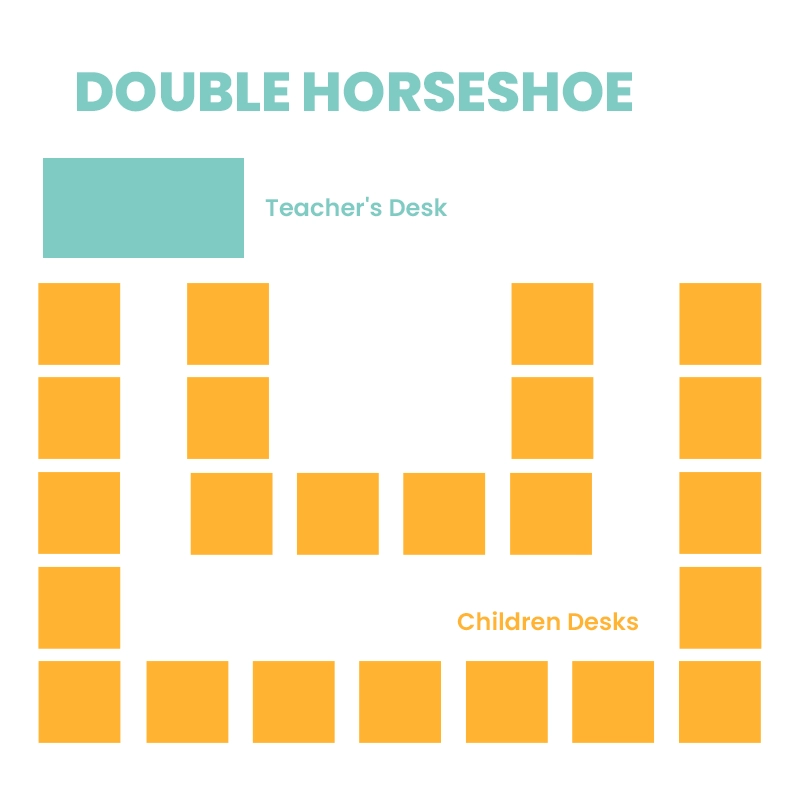
Double Horseshoe
This is an extension of the horseshoe arrangement with two U-shaped rows.
- Cons: Requires a large classroom to be effective
- Best for: Classrooms with more students who need engagement
- Pros: Balances teacher interaction and student collaboration
Collaborative Seating Arrangements (Student-Centered)
Collaborative classroom seating arrangements encourage teamwork, discussion, and peer learning. These setups are ideal for hands-on activities and group work.
Roundtable Seating
Students sit around a circular or rectangular table, facing each other.
- Cons: Not ideal for teacher-centered instruction
- Best for: Group discussions, cooperative learning
- Pros: Fosters communication, teamwork, and active participation


Pods / Groups of 4-6
Students are seated in small clusters to work together on projects and discussions.
- Cons: Can become noisy and more complex to manage
- Best for: Interactive learning, project-based work
- Pros: Encourages peer support and collaboration
Conference-Style Seating
Desks are arranged in two long rows facing each other, like a conference room.
- Cons: It may not be ideal for writing-intensive tasks
- Best for: Debates, storytelling, literature discussions
- Pros: Encourages active listening and participation
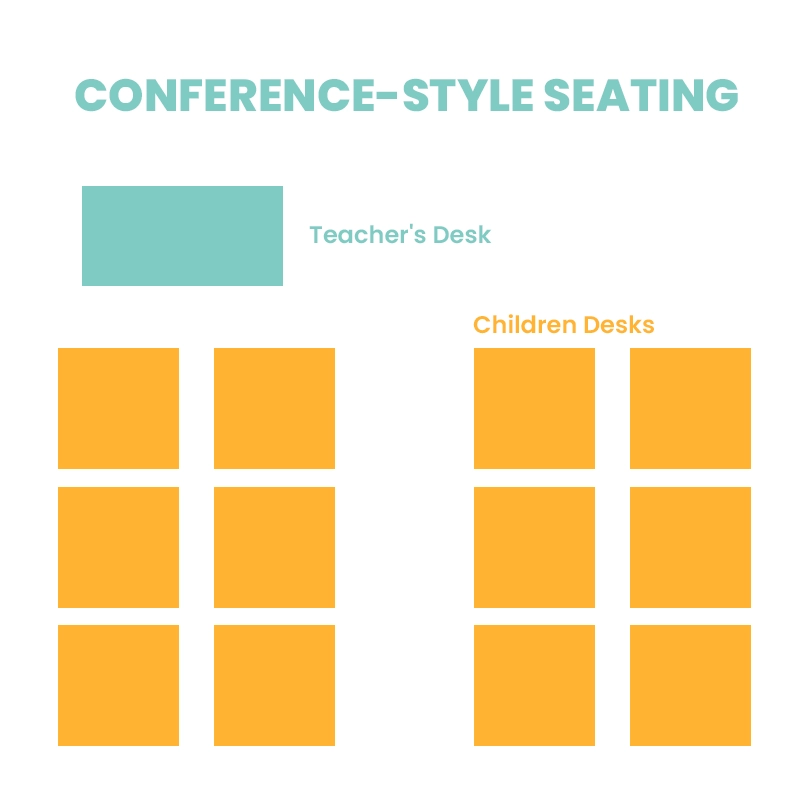

U-Shape & Double U-Shape
Desks form a U or double U shape, allowing students to see the teacher and each other.
- Cons: Requires more space than traditional rows
- Best for: Discussions, presentations, interactive lessons
- Pros: Balances engagement and visibility
Modern & Flexible Classroom Seating Arrangements
Modern classrooms often incorporate flexible seating options that allow students to choose where and how they sit, improving comfort and focus.
Herringbone Layout
Desks are arranged in a staggered diagonal pattern, like a herringbone shape.
- Cons: It can be challenging to arrange in small classrooms
- Best for: Interactive lessons, maintaining structure while allowing movement
- Pros: Encourages participation, gives students a clear view of the teacher


Circle or Half-Circle Seating
Students sit in a full or semi-circle, facing each other.
- Cons: Not ideal for individual tasks or note-taking
- Best for: Class discussions, storytelling, drama activities
- Pros: Encourages inclusivity and open communication
Flexible Seating (Bean Bags, Standing Desks, Floor Seating, Wobble Chairs, etc.)
This arrangement includes non-traditional seating options that allow movement and adaptability.
- Cons: Requires clear classroom rules and expectations
- Best for: Creative learning spaces, students who need movement
- Pros: Supports active learning, increases engagement

Best Seating Arrangements for Different Classroom Needs
Not every classroom seating arrangements works for every class. The best classroom seating arrangement depends on class size, student behavior, and learning objectives. Below are seating recommendations for different classroom scenarios to help optimize student engagement and classroom management.
Best Seating for Small Classrooms – Maximizing Limited Space
Small classrooms require efficient use of space to ensure students can move comfortably while maintaining an effective learning environment.
- Recommended Seating Arrangements:
- Horseshoe or U-shaped classroom seating arrangement – Maximizes teacher-student interaction.
- Pods or clusters of 4-6 desks – Supports small-group collaboration without overcrowding.
- Flexible classroom seating arrangements – Allows rearranging based on lesson activities.
- Why It Works:
- Reduces clutter and maximizes floor space.
- Keeps students close to the teacher for better interaction.
- Makes small spaces feel more open and structured.
Best Seating for Large Classrooms – Maintaining Student Engagement
In large classrooms, the biggest challenge is keeping students focused and engaged while ensuring they can see and hear the teacher.
- Recommended Seating Arrangements:
- Traditional rows and columns – Best for structured, lecture-based learning.
- Double horseshoe or tiered seating – Helps all students stay engaged.
- Pods or roundtable seating arrangements in classrooms – Ideal for group activities.
- Why It Works:
- Ensures that all students have a clear view of the teacher.
- Prevents students in the back from feeling disconnected.
- Provides structured movement paths for classroom management.
Ideal Seating for 10, 15, 20, 25, and 30 Students
Class size impacts how classroom seating arrangements should be structured.
| Class Size | Recommended Seating Arrangement |
|---|---|
| 10 Students | Circle or semicircle seating arrangement in classrooms to encourage discussions. |
| 15 Students | U-shaped classroom seating arrangement for better teacher interaction. |
| 20 Students | Pods or small clusters to balance collaboration and structure. |
| 25 Students | Double horseshoe or roundtable seating arrangements in classrooms for group activities. |
| 30 Students | Traditional row seating or flexible classroom seating arrangement to accommodate movement. |
- Why It Works:
- Adapts to different teaching styles.
- Ensures every student has an optimal seating position.
- Helps with classroom management by maintaining organization.
Seating for Highly Active or Talkative Students – Managing Energy Levels
Some students struggle with focus and self-regulation, so classroom seating arrangements should help manage energy levels while keeping engagement high.
- Recommended Seating Arrangements:
- U-shaped classroom seating arrangement – Keeps students involved while limiting distractions.
- Flexible seating with standing desks – Helps restless students stay focused.
- Structured row seating – Reduces excessive socializing.
- Why It Works:
- Provides apparent teacher supervision.
- Reduces excess movement that might disrupt learning.
- Allows active students to engage in controlled ways.
Seating for Quiet and Shy Students – Encouraging Participation
Shy students often need seating arrangements that make them feel comfortable and included while gradually building confidence.
- Recommended Seating Arrangements:
- Pods with a mix of confident and shy students – Encourages peer support.
- A semicircle or roundtable classroom seating arrangement Creates a less intimidating discussion setting.
- Flexible classroom seating – Allows shy students to choose where they feel most comfortable.
- Why It Works:
- Reduces anxiety in classroom discussions.
- Encourages gradual participation in a supportive way.
- Helps students feel included in the learning process.
Culturally Responsive Seating Arrangements – Supporting Diverse Learning Environments
A culturally inclusive classroom seating arrangement ensures all students feel valued and engaged.
- Recommended Seating Arrangements:
- Flexible classroom seating arrangements – Allows students to sit in ways that align with cultural learning preferences.
- Pods or collaborative clusters – Encourages diverse perspectives in group work.
- Circle or semicircle seating arrangement in classrooms – Promotes equity in classroom discussions.
- Why It Works:
- Supports different communication and interaction styles.
- Encourages collaboration among students from different backgrounds.
- Creates a more inclusive and dynamic learning environment.
Different seating arrangements cater to different classroom sizes, student behaviors, and teaching objectives. By understanding how seating affects engagement and learning, teachers can effectively adapt layouts to meet their students’ needs.
A well-planned classroom seating arrangement ensures students feel comfortable, engaged, and supported, leading to better learning outcomes.
Don’t just dream it, design it! Let’s chat about your custom furniture needs!
How Seating Arrangements Affect Student Learning & Behavior
Well-planned classroom seating arrangements significantly impact student learning, behavior, and engagement. How arranged desks and chairs support or hinder focus, participation, social interaction, and teacher-student communication.
Impact on Student Focus and Attention – Minimizing Distractions
The right classroom seating arrangement helps students stay focused and attentive, especially in kindergarten and elementary classrooms where children are easily distracted. Traditional row seating often keeps students facing the front, which reduces side conversations but may limit interaction. In contrast, small group seating or U-shaped layouts can improve engagement but might increase distractions if not appropriately managed.
- Place easily distracted students near the front or close to the teacher.
- Avoid placing students near high-traffic areas like doors or supply stations.
- Use seating charts strategically to separate disruptive students.
A classroom seating arrangement that considers student attention span and learning needs can create a more structured and productive learning environment.
Influence on Participation & Engagement – Encouraging Classroom Involvement
Classroom seating directly affects student participation. Some layouts, like circle or half-circle arrangements, encourage discussions and active involvement, making students feel more comfortable sharing ideas. On the other hand, rows and columns may limit interaction but work well for direct instruction.
- Use flexible seating to let students choose a setup that suits their learning style.
- Incorporate collaborative classroom seating arrangements, like pods or roundtable seating, to promote peer engagement.
- Position quieter students in small groups where they feel encouraged to speak.
Seating that fosters classroom engagement leads to better collaboration, communication, and overall learning outcomes.
How Seating Affects Peer Interaction and Social Skills Development
Children develop essential social skills through classroom interactions. Classroom seating arrangements like pods or roundtables encourage teamwork, sharing, and communication. However, some students may struggle with group settings, so teachers need to balance individual and collaborative seating options.
- Pair students with complementary strengths in group seating.
- Rotate classroom seating arrangements periodically to expose students to different peers.
- Use a mix of independent and group-based seating to develop self-reliance and teamwork.
An effective seating plan builds a supportive social environment, helping students learn cooperation and communication.
Teacher-Student Interaction Levels Based on Seating Design
Classroom seating arrangements impact how easily teachers can interact with students. In a U-shaped or semicircle layout, teachers can move freely and make eye contact with every student, improving engagement. In contrast, traditional row seating may make it harder for teachers to interact with students sitting at the back.
To improve teacher-student interaction:
- Use a U-shape or double horseshoe for better visibility and accessibility.
- Arrange flexible seating that allows teachers to move around quickly.
- Avoid isolating students in corners where they may feel disconnected.
A well-structured classroom seating arrangements enhances teacher engagement, ensuring all students receive attention and support.
Psychological Effects of Sitting in Different Areas of the Classroom
Where a student sits in the classroom can affect their confidence, participation, and engagement. Students who sit at the front often feel more connected to the teacher, while those at the back may feel less involved. Some students prefer sitting near windows for comfort, which can lead to distractions.
- Identify students who need extra support and position them closer to the teacher.
- Encourage shy students to sit in group settings where they feel included.
- Use flexible seating options to accommodate different student needs.
Teachers can design a classroom environment that supports emotional well-being and confidence by understanding how seating placement influences student behavior.
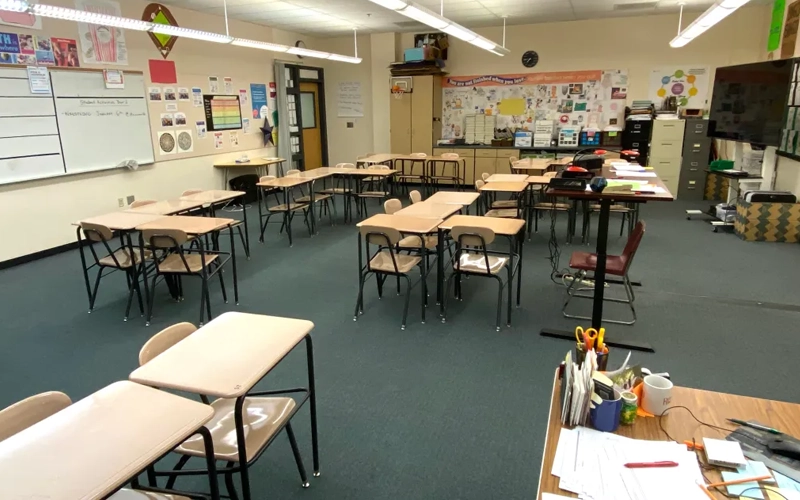
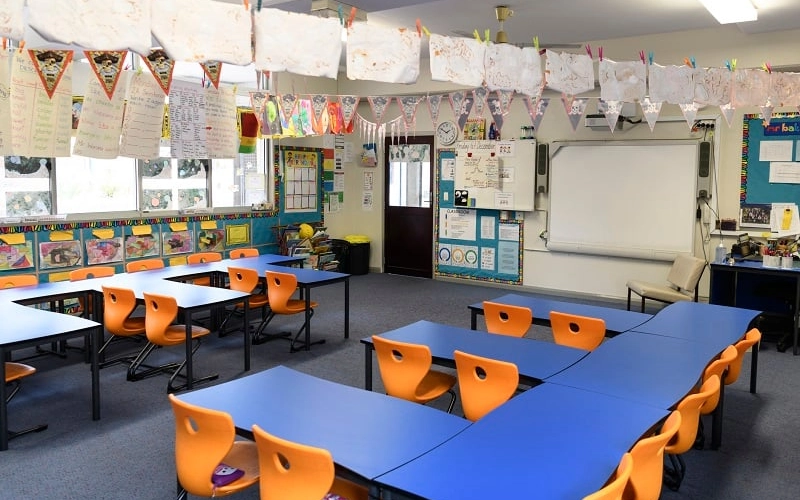
Practical Implementation: Assigning & Managing Seating in Children’s Classrooms
Once teachers understand the impact of classroom seating arrangements, the next step is effectively assigning and managing seats to support learning and behavior.
How to Assign Seats Strategically – Random vs. Structured Seating
- Random seating allows students to choose where they sit, giving them a sense of independence.
- Structured seating places students based on learning styles, behavior, and engagement levels.
For kindergarten and elementary students, structured seating is often more effective because it helps:
- Balance group dynamics (mixing talkative and quiet students).
- Ensure all students can see the teacher and board.
- Support individual learning needs (placing struggling students near the teacher).
Teachers can adjust seating charts throughout the school year to reflect academic progress and behavioral needs.
Should Students Sit in Rows or Groups? – Weighing the Pros & Cons
The decision between row and group seating depends on the teaching style and classroom goals.
| Seating Type | Pros | Cons |
|---|---|---|
| Rows & Columns | Good for discipline, independent work, and test-taking | Limits interaction, less engagement |
| Pods/Clusters | Encourages teamwork, discussion, and collaboration | Can be noisy and harder to manage |
| U-Shape | Balances participation and visibility | Requires more space |
| Flexible Seating | Supports different learning styles, increases engagement | Needs structure to avoid chaos |
Group-based seating is often preferred for children to foster interaction and teamwork, while row seating is helpful for independent tasks.
How to Make Seating Charts for Kindergarten & Elementary Classrooms
Creating an effective seating chart for kindergarten and elementary classrooms requires a thoughtful approach considering student needs, behavior, and learning styles. A well-designed seating chart optimizes classroom management, encourages engagement, and supports different learning styles, ensuring every child feels comfortable and included in the learning process.
1. Understand Classroom Goals Before Creating a Seating Chart
Before assigning seats, teachers should consider:
- Is the class’s primary learning style mostly lecture-based, discussion-based, or hands-on activities?
- Classroom size and layout – Are there space constraints, or can desks be rearranged flexibly?
- Behavioral considerations – Which students need extra supervision? Who works best independently?
- Social dynamics – Are there students who should be seated together or apart for better focus?
A seating chart should align with classroom objectives, ensuring the setup promotes focus and collaboration.
2. Choosing the Right Seating Arrangement for Your Classroom Needs
The type of classroom seating arrangement chosen will influence how the seating chart is structured.
- Rows & Columns – Best for structured learning, helps reduce distractions.
- Pods/Clusters of 4-6 – Encourages teamwork and discussion.
- U-Shape or Horseshoe – Facilitates group discussions and teacher visibility.
- Flexible Seating – Students can choose their seats based on comfort and learning style.
Flexible seating or clusters are often preferred for kindergarten to support play-based learning and interaction. In elementary classrooms, a combination of rows for independent work and groups for discussions works well.
3. Step-by-Step Guide to Making a Seating Chart
Step 1: Gather Student Information
To make an effective seating chart, teachers should gather relevant details about students, such as:
- Learning styles (visual, auditory, kinesthetic)
- Behavioral needs (who needs more supervision, who gets easily distracted)
- Social relationships (who works well together, who needs to be separated)
- Special accommodations (students with disabilities or specific needs)
A simple way to do this is to observe students’ behavior during the first few weeks of school or use student feedback surveys.
Step 2: Map Out the Classroom Layout
Using a whiteboard, paper, or digital tool, sketch out your classroom, including:
- Teacher’s desk and board location
- Doorways, windows, and storage areas
- Fixed furniture (shelves, sinks, computer stations, etc.)
- Available desk and chair arrangements
This will help determine where students can sit without obstructions and how to maximize space.
Step 3: Assign Seats Strategically
Now that you understand your students and classroom layout, it’s time to assign seats based on needs:
- Front of the Classroom: Ideal for students who need extra support, are easily distracted, or have hearing/vision impairments.
- Middle of the Classroom: Best for independent workers who don’t need constant supervision but still benefit from teacher proximity.
- Back of the Classroom: Suitable for students who can work independently without distractions.
- Near Windows or Doors: This is not ideal for easily distracted students but is suitable for students needing quick medical access.
Teachers should also balance social interactions:
- Pair shy students with more confident peers to encourage participation.
- Separate students who tend to talk excessively.
- Avoid isolating students with special needs; instead, integrate them where they receive support while feeling included.
Step 4: Test and Adjust the Seating Chart
After implementing the seating chart, observe how it works for at least one or two weeks. Pay attention to:
Which students are more engaged or distracted
Any conflicts or disruptions
Whether learning styles are being supported
Adjust as needed—a seating chart should be flexible and adapt to student needs throughout the school year.
4. Tools for Creating Digital Seating Charts
Teachers can use digital tools to create and adjust seating charts easily:
- Google Slides / PowerPoint – Simple and customizable for visualizing layouts.
- Classroom Architect (classroom.4teachers.org) – An interactive tool for designing classroom layouts.
- SmartDraw – A professional tool for drawing seating charts.
- Canva – Easy drag-and-drop classroom templates for seat planning.
Teachers can quickly rearrange students, print layouts, and make necessary adjustments throughout the year using digital seating chart tools.
A well-structured seating chart for kindergarten and elementary classrooms enhances learning, improves classroom management, and supports student engagement. By considering learning styles, behavior, social dynamics, and classroom layout, teachers can create a classroom seating arrangement that meets the needs of all students.
Seating charts shouldn’t be static. Teachers should observe, adjust, and optimize them throughout the school year to ensure students have the best learning environment.

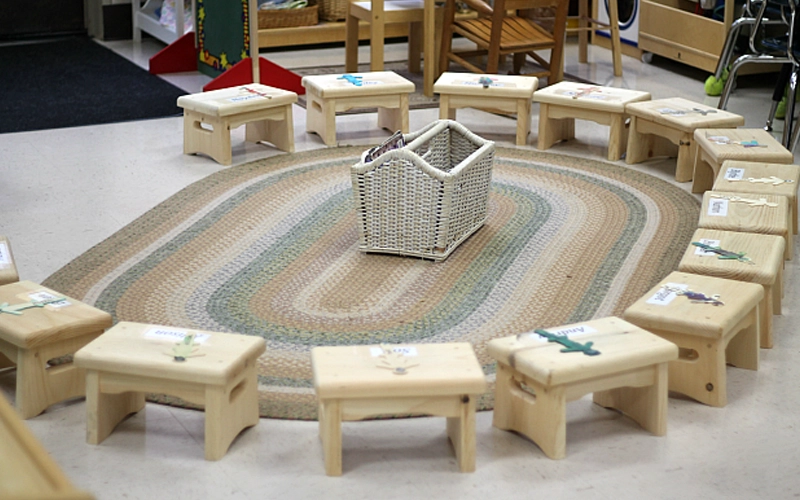
Tips for Adjusting Seating Arrangements Throughout the School Year
Seating needs to change over time, so adjustments are necessary. Best practices include:
- Observing student behavior and making changes when needed.
- Rotating seats regularly to give students different perspectives.
- Using flexible seating options to adapt to different activities.
Common Classroom Seating Challenges and How to Overcome Them
Some common classroom seating challenges include:
- Students complaining about assigned seats – Solution: Allow occasional seat swaps.
- Disruptions in group seating – Solution: Set clear behavior expectations.
- Students feeling isolated in large classrooms – Solution: Use a mix of independent and collaborative seating.
Teachers can create a positive, productive learning environment that supports student focus, participation, and classroom management by strategically assigning and managing seating.
Subject-Specific Seating Arrangements for Kindergarten & Elementary Students
Different subjects require different classroom seating arrangements to optimize student learning, engagement, and classroom management. A well-planned seating arrangement in classrooms ensures that students can interact, focus, and participate effectively. Choosing the right configuration can significantly impact student engagement and learning outcomes, whether it’s a STEM classroom seating arrangements, a language and literacy-focused layout, or an art and music setup.
Best Seating for STEM (Science, Technology, Engineering, Math) Activities
STEM activities often involve hands-on experiments, group projects, and interactive problem-solving, so the best classroom seating arrangements for STEM should facilitate collaboration and accessibility.
- Recommended Classroom Seating Arrangements:
- Pods or clusters of 4-6 students – Encourages teamwork on engineering and coding projects.
- U-shaped classroom seating arrangements – Ensures all students can see demonstrations while maintaining discussion space.
- Flexible classroom seating arrangements – Standing desks and mobile workstations allow students to move freely between different tasks.
- Why It Works:
- Encourages critical thinking and problem-solving.
- Supports collaborative learning.
- Provides easy access to lab materials and technology.
For science classrooms, seating arrangements in a small room should ensure clear teacher-student visibility, while in larger classrooms, multiple workstations help organize experiments efficiently.
Best Seating for Language, Literacy & Storytelling
In language and literacy-focused classrooms, students must engage in discussions, participate in read-aloud sessions, and collaborate on writing activities. The best classroom seating arrangement for classroom engagement in these settings focuses on face-to-face interaction and accessibility.
- Recommended Seating Arrangements:
- Roundtable or cluster seating arrangements in classrooms – Encourages active discussions and shared reading.
- Circle or semicircle seating arrangement in classrooms – Promotes open dialogue during storytelling and poetry reading.
- Flexible classroom seating arrangements – Bean bags, carpet seating, and rocking chairs create a comfortable environment for independent reading.
- Why It Works:
- Fosters oral language development and storytelling skills.
- Encourages peer discussions and engagement.
- Creates a welcoming, comfortable learning space.
For elementary classroom seating arrangements, providing small reading corners with alternative seating arrangements in classrooms helps reluctant readers feel more comfortable participating.
Best Seating for Art, Music, and Creative Activities
Creative subjects require open, flexible, and dynamic classroom seating arrangements, allowing students to explore artistic expression freely. The best seating arrangement for an art classroom differs from a traditional classroom seating arrangements because it prioritizes movement and accessibility to materials.
- Recommended Seating Arrangements:
- Cluster seating arrangement in classrooms – Supports group collaboration on art projects.
- Flexible seating options – Floor seating, standing desks, and stools allow students to move as they create.
- Horseshoe or U-shaped arrangements – Ideal for music classrooms where students need to see the teacher/conductor.
- Why It Works:
- Encourages creativity and movement.
- Supports group and independent projects.
- Provides easy access to art supplies and instruments.
For music classrooms, the best classroom seating arrangements for small classrooms involve placing students in semicircles to improve engagement and interaction with the instructor.
Best Seating for Special Needs and Inclusive Classrooms
Classroom seating arrangements for students with special needs should be accessible, adaptable, and supportive of diverse learning styles. Flexible seating arrangements in classrooms help accommodate students who require movement-friendly setups, while structured rows may work better for those needing reduced distractions.
- Recommended Classroom Seating Arrangements:
- Flexible seating classroom arrangement – Wobble chairs, standing desks, and quiet zones support different sensory needs.
- Traditional classroom seating arrangements with modifications – Assigned seating near the teacher for students needing additional support.
- Pods or U-shaped classroom seating arrangements – Encourages peer support while ensuring teacher accessibility.
- Why It Works:
- Provides equal learning opportunities for all students.
- Encourages interaction without overwhelming sensory-sensitive students.
- Supports personalized learning environments.
For culturally responsive classroom seating arrangements, a combination of structured and flexible seating can ensure every student feels included and valued.
Classroom Seating Arrangements: Pros and Cons
There are no one-size-fits-all classroom seating arrangements, and each layout has advantages and drawbacks. The best classroom seating arrangements depend on class size, learning objectives, and student needs.
| Classroom Seating Arrangement | Pros | Cons |
|---|---|---|
| Rows & Columns | Best for structured learning, easy to manage | Limits student collaboration |
| Pods/Clusters | Encourages teamwork and discussion | Can become noisy and distracting |
| Roundtable Seating | Fosters communication and engagement | Takes up more space |
| U-Shaped Seating | Improves teacher visibility and student interaction | Requires more room |
| Flexible Seating | Supports movement and learning preferences | Needs clear classroom rules to stay organized |
| Circle or Half-Circle | Great for discussions and storytelling | Not ideal for writing-intensive tasks |
Different classroom seating arrangements may be necessary throughout the year for small classrooms. A teacher can rotate between row seating for assessments and clusters for group work, ensuring a balance between focus and collaboration.
Well-planned classroom seating arrangements significantly impact student engagement, focus, and classroom management. Teachers can create a more effective and supportive learning environment by selecting the best seating arrangement for different subjects and adapting layouts based on classroom needs.
- Different classroom seating arrangements serve different educational purposes.
- Flexible seating options provide adaptability for various learning needs.
- Seating arrangements in elementary classrooms should balance structure and creativity.
- The best classroom seating arrangement is one that evolves with student needs.
Educators can optimize student participation, collaboration, and academic success by carefully considering classroom seating arrangements and their advantages and disadvantages.
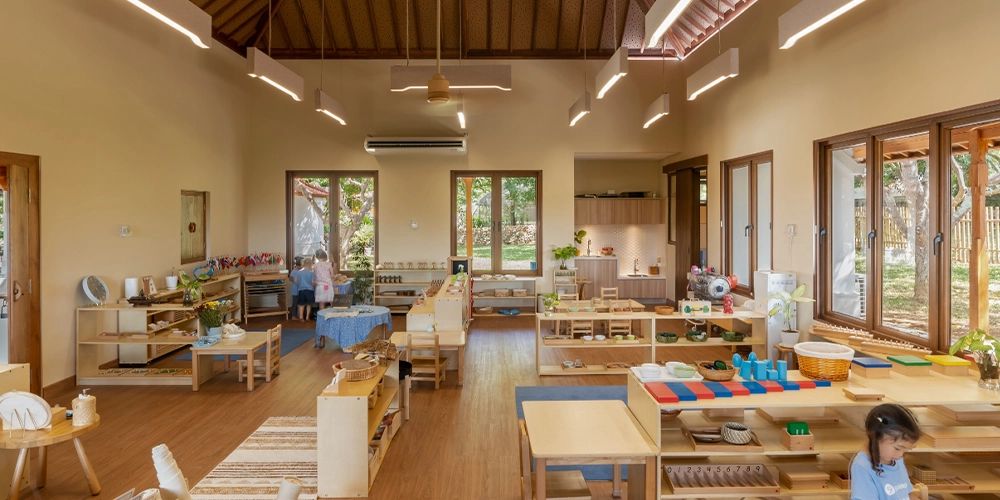
Real-World Classroom Seating Strategies & Expert Insights
Adequate classroom seating arrangements are vital in student engagement, focus, and behavior management. While there is no one-size-fits-all solution, experienced educators and research studies provide valuable insights into how different classroom seating arrangements affect learning outcomes. Below are three key strategies that teachers can apply in kindergarten and elementary classrooms.
Strategy 1: Using Flexible Classroom Seating to Improve Student Engagement
Many teachers have experimented with flexible classroom seating arrangements to provide students with choices in where and how they learn. This approach replaces fixed desks and chairs with various seating options such as:
- Bean bags, floor seating, and wobble chairs for active learners
- Standing desks and mobile seating for students who need movement
- Pods or roundtable seating for collaboration and group discussions
Why It Works:
- Encourages student autonomy and comfort, leading to better focus.
- Supports different learning styles, making lessons more engaging.
- Reduces disruptive behavior by allowing students to choose seating that suits their needs.
A flexible classroom seating arrangement is beneficial in early education settings, where students benefit from movement and choice in their learning environment.
Strategy 2: Optimizing U-Shaped Seating for Better Teacher-Student Interaction
The U-shaped classroom seating arrangements are an excellent choice for teachers who prefer structured classroom seating arrangements. This setup allows all students to have clear visibility of the teacher while maintaining a structured yet interactive environment.
Best Practices for U-Shaped Seating:
- Position talkative students closer to the teacher to maintain focus.
- Use this classroom seating arrangement for lessons that involve demonstrations or discussions.
- Ensure enough space in the middle of the “U” for teacher movement and student presentations.
Benefits:
- Improves teacher-student communication.
- Reduces distractions by keeping all students facing forward.
- Works well in both small and large classrooms, making it a versatile classroom seating arrangement.
Strategy 3: Using Group-Based Classroom Seating Arrangements to Enhance Collaboration
A group-based classroom seating arrangement, such as pods or cluster seating, is ideal for interactive and peer-supported learning. Many elementary classrooms implement this setup to encourage:
- Cooperative learning in subjects like science, literacy, and problem-solving activities.
- Social development, helping students improve teamwork and communication skills.
- Engagement in classroom discussions, as students feel more comfortable sharing ideas in small groups.
Tips for Effective Group Seating Arrangements:
- Rotate groups every 4-6 weeks to expose students to different perspectives.
- Ensure a balance of independent learners and collaborative students in each pod.
- Visual markers (such as color-coded seating areas) help students understand group roles.
This classroom seating arrangement is particularly effective in kindergarten and elementary school settings, where social learning is critical to child development.
While different classroom seating arrangements serve other purposes, the key to success is adaptability. Teachers should:
- Experiment with multiple classroom seating arrangements to see what works best for their students.
- Combine structured and flexible seating to balance focus and engagement.
- Adjust seating arrangements based on class dynamics, lesson objectives, and student needs.
By implementing evidence-based classroom seating strategies, teachers can create an environment that supports learning, collaboration, and student well-being.
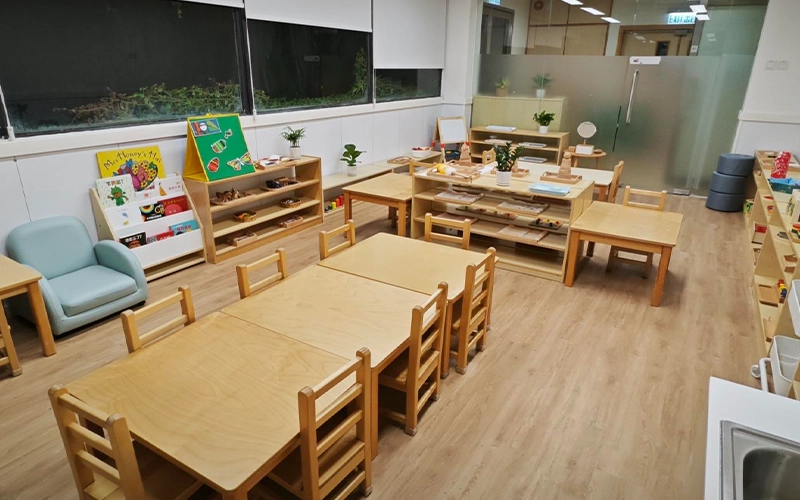
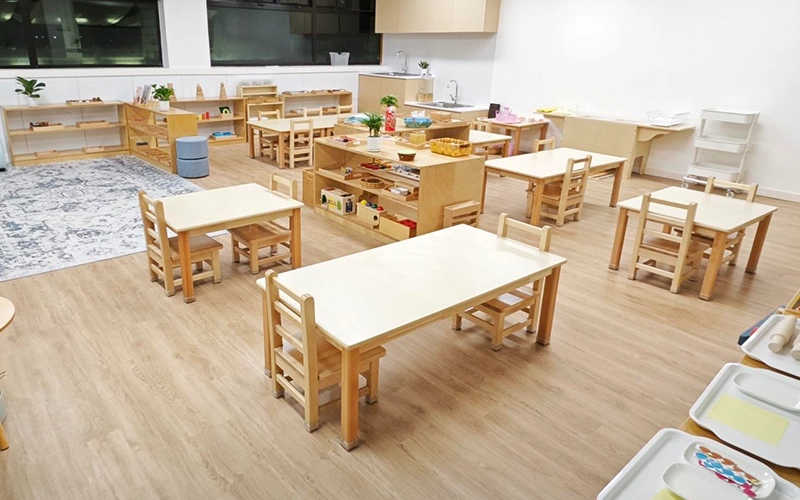
Conclusion
Choosing the right classroom seating arrangement is essential for creating an effective learning environment in kindergarten and elementary classrooms. How seats are arranged impacts student engagement, focus, collaboration, and classroom management.
There is no universal best classroom seating arrangement, as different layouts serve different purposes. Traditional row seating works well for structured learning, while pods and flexible seating arrangements encourage interaction and active participation. U-shaped and roundtable layouts improve teacher-student communication and discussions.
To optimize learning, teachers should experiment with different classroom seating arrangements, adjust seating based on student needs, and remain flexible. A well-planned classroom seating arrangement creates a supportive, inclusive, and engaging space where students can thrive.
